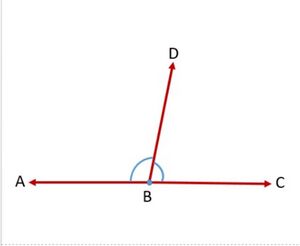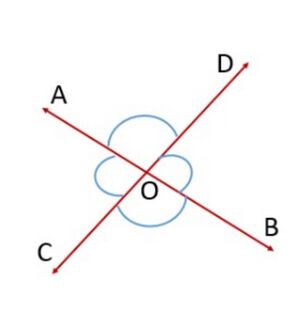कोणों के युग्म: Difference between revisions
No edit summary |
(added content) |
||
| Line 1: | Line 1: | ||
जब कोण किसी निश्चित ज्यामितीय गुण को प्रदर्शित करने के लिए दो के समूह में दिखाई देते हैं तो उन्हें कोण युग्म कहा जाता है।कोण युग्मों के बीच एक विशेष संबंध होता है। कुछ कोण युग्मों में पूरक कोण, संपूरक कोण, ऊर्ध्वाधर कोण, वैकल्पिक आंतरिक कोण, वैकल्पिक बाह्य कोण, संगत कोण और आसन्न कोण शामिल हैं। | |||
== | == कोणों का रैखिक युग्म == | ||
When two lines intersect each other, the adjacent angles make a linear pair. The sum of linear pairs is <math>180^\circ</math>. It should be noted that all linear pairs are supplementary because supplementary angles sum up to <math>180^\circ</math>. However, all supplementary angles need not be linear pairs because in linear pairs the lines need to intersect each other to form adjacent angles. In the following figure, <math>\angle ABD</math> and <math>\angle CBD</math> form a linear pair and their sum is equal to <math>180^\circ</math>. <math>\angle ABD+\angle CBD=180^\circ</math> | When two lines intersect each other, the adjacent angles make a linear pair. The sum of linear pairs is <math>180^\circ</math>. It should be noted that all linear pairs are supplementary because supplementary angles sum up to <math>180^\circ</math>. However, all supplementary angles need not be linear pairs because in linear pairs the lines need to intersect each other to form adjacent angles. In the following figure, <math>\angle ABD</math> and <math>\angle CBD</math> form a linear pair and their sum is equal to <math>180^\circ</math>. <math>\angle ABD+\angle CBD=180^\circ</math> | ||
[[File:Linear Pair of angles.jpg|alt=Fig. 1 - Linear Pair of angles|none|thumb|Fig. 1 - Linear Pair of angles]] | [[File:Linear Pair of angles.jpg|alt=Fig. 1 - Linear Pair of angles|none|thumb|Fig. 1 - Linear Pair of angles]] | ||
== | == रैखिक युग्म अभिगृहीत == | ||
'''Axiom 1''': If a ray stands on a line, then the sum of two adjacent angles so formed is <math>180^\circ</math>. | '''Axiom 1''': If a ray stands on a line, then the sum of two adjacent angles so formed is <math>180^\circ</math>. | ||
Revision as of 08:08, 27 June 2024
जब कोण किसी निश्चित ज्यामितीय गुण को प्रदर्शित करने के लिए दो के समूह में दिखाई देते हैं तो उन्हें कोण युग्म कहा जाता है।कोण युग्मों के बीच एक विशेष संबंध होता है। कुछ कोण युग्मों में पूरक कोण, संपूरक कोण, ऊर्ध्वाधर कोण, वैकल्पिक आंतरिक कोण, वैकल्पिक बाह्य कोण, संगत कोण और आसन्न कोण शामिल हैं।
कोणों का रैखिक युग्म
When two lines intersect each other, the adjacent angles make a linear pair. The sum of linear pairs is . It should be noted that all linear pairs are supplementary because supplementary angles sum up to . However, all supplementary angles need not be linear pairs because in linear pairs the lines need to intersect each other to form adjacent angles. In the following figure, and form a linear pair and their sum is equal to .
रैखिक युग्म अभिगृहीत
Axiom 1: If a ray stands on a line, then the sum of two adjacent angles so formed is .
Axiom 2: If the sum of two adjacent angles is , then the non-common arms of the angles form a line.
In Fig.1 is the common arm , and are the non-common arms.
Theorem 1
If two lines intersect each other, then the vertically opposite angles are equal.
Proof : In the statement above, it is given that ‘two lines intersect each other’. So, let and be two lines intersecting at as shown in Fig. 2. They lead to two pairs of vertically opposite angles, namely, (i) and (ii) and . We need to prove that and
Now, ray stands on line .
Hence
ray stands on line .
Hence
From (1) and (2)
stands on line .
Hence
From (1) and (3)

